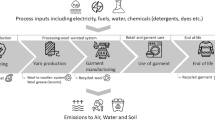Abstract
GLASSFORM-Version 1, a spreadsheet or an algorithm software package, was developed for generating preliminary glass formulations for waste streams. A spreadsheet program on Microsoft Excel 97 for Windows 95 was also developed for predicting key glass properties for laboratory scale vitrification studies of simulated waste streams. The algorithm version based on Modula 2, which can be run on Windows-95 or NT, was developed to plot the glass component ratios versus the waste loading. At this time the algorithm was not developed for predicting the key glass properties. The spreadsheet or the algorithm version is an effective tool for developing preliminary glasses with a potential to be chemically durable, dense for volume reduction, of low viscosity for glass pouring, redox controlled, and resistant to corrosion of melter components such as Inconel 690. For a given solid waste stream oxide composition in wt.% or in grams or in ppm and waste loading in wt.%, the spreadsheet or the algorithm calculates glass component ratios that provide an empirical indication of the quality of a candidate glass. In addition to the component ratios for glass quality indicators, glass property composition relationships for glass durability and processability were incorporated into the spreadsheet version. These spreadsheet or algorithm versions can also be used for studying the effects of such actions as varying waste loadings or of varying individual waste components on glass properties and glass component ratios, provided specific glass property models are incorporated. As an example, the software was applied to candidate phosphate-containing glasses at the Idaho Nuclear Technology and Engineering Center (INTEC, previously Idaho Chemical Processing Plant) and also the borosilicate glasses such as the Savannah River Laboratory Environmental Assessment (EA) glass, the Hanford standard (ARM-1) glass, and the French R7T7 glass. Application of the software to new waste streams such as at Hanford, Fernald, and other countries is the most useful aspect of the GLASSFORM software during the early stages of glass waste form development.
Similar content being viewed by others
References
Krishna Vinjamuri, “Candidate Glass-Ceramic Waste Forms for Immobilization of the Calcines Stored at the Idaho Chemical Processing Plant,” Environmental Issues and Waste Management Technologies in the Ceramic and Nuclear Industries, edited by Jain Vijay and Palmer Ron, Ceramic Transactions, Volume 61, pp. 439–446, 1995.
Krishna Vinjamuri, “Glass Waste Forms for the Sodium-Bearing High Activity Waste Fractions,” INEL-95/0214, June 1995.
Krishna Vinjamuri, GLASSFORM-Version 1: An Algorithm for Generating Preliminary Glass Formulations for Waste Streams, INEEL/EXT-98-00269, March 1998.
P. Hrma, G.F. Piepel, J.D. Vienna, P.E. Redgate, M.J. Schweiger, and D.E. Smith, “Prediction of Nuclear Waste Glass Dissolution As a Function of Composition” Ceramic Transactions, Volume 61, pp. 497–504, 1995.
P. Hrma, G.F. Piepel, P.E. Redgate, D.E. Smith, and M.J. Schweiger, “Prediction of Processing Properties for Nuclear waste Glasses,” Ceramic Transactions, pp. 505–5 13, 1995.
J. Zarzycki, Glass and Vitreous State, Cambridge Solid State Science Series, Cambridge University Press, New York, 1991, pp. 237–239.
A.A. Hench and L.L. Hench, J. Nucl. Chem. Waste Management IV, 231 (1983).
A.K. Varshneya, Fundamentals of Inorganic Glasses, Academic Press, New York, 1993.
H.D. Schreiber, B.K. Kochanowski, and C.W. Schreiber, “Compositional Effects on the Iron Redox State in Model Glasses for Nuclear Waste Immobilization,” Ceramic Transactions, Volume 39, pp. 141–150, 1994.
W.T. Goldston and M.J. Plodinec, “The DWPF Strategy for Producing an Acceptable Product,” Ceramic Transactions, Volume 23, Nuclear Waste Management IV, American Ceramic Society, Inc., 1991, pp. 443–452.
G.B. Mellinger and J.L. Daniel, “Approved Reference and Testing Materials for Use in Nuclear Waste Management Research and Development Program,” USDOE Report, PNL-4955-1, December 1983.
H. Matzke and E. Vernaz, “Thermal and Physicochemical Properties Important for Long Term Behavior of Nuclear Waste Glasses,” J. Nuc. Mater. 201, 1993, pp. 295–309.
C. M. Jantzen, N. E. Bibler, D. C. Beam, C. L. Crawford, and M. A. Picket, “Development and Characterization of the Defense Waste Processing Facility (DWPF) Environmental Assessment (EA) Glass Standard Reference Material (U),” Ceramic Transactions, Volume 39, 1993, pp. 313–322.
C.M. Jantzen, “First Principle Process-Product Control Models for Vitrification of Nuclear Waste: Relationship of Glass Composition to Glass Viscosity, Resistivity, Liquidus Temperature and Durability,” Ceramic Transactions, Volume 23, 1991, pp. 37–51.
Author information
Authors and Affiliations
Rights and permissions
About this article
Cite this article
Vinjamuri, K., Scholes, B.A., Wood, S.T. et al. Glassform-Version 1: A Spreadsheet or an Algorithm for Generating Preliminary Glass Formulations for Waste Streams. MRS Online Proceedings Library 556, 391 (1998). https://doi.org/10.1557/PROC-556-391
Published:
DOI: https://doi.org/10.1557/PROC-556-391




